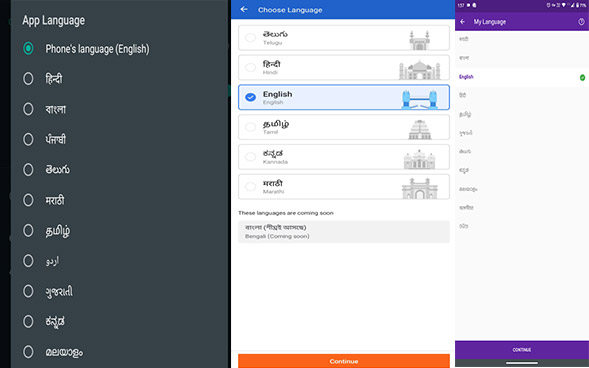While many applications in the domain of e-commerce like payments gateways etc. have managed to achieve inclusion through introducing languages, edtech apps have a lot of catching up to do
International Mother Language Day has been observedon21stFebruary since 2000to promote linguistic and cultural diversity and multilingualism. The theme of this year’s International Mother Language Day was “Fostering multilingualism for inclusion in education and society”[1]
UNESCO notes that this year’s observance is “a call on policymakers, educators and teachers, parents and families to scale up their commitment to multilingual education, and inclusion in education to advance education recovery in the context of COVID-19.”[2]
With increasing penetration of internet, especially in tier 2 and 3 cities, Google has found that 90% of new internet users are consuming content in vernacular medium. They found that adoption of vernacular entertainment and chat applications is greatest, followed by digital news and social media platforms.[3]
Google has been the frontrunner in using these insights to bring products which appeal to India as a multilingual country by launching AI assistants, new features in Google Maps and other products. Even in the India Digitization fund announced at the peak of COVID -19 pandemic in July 2020, Google Indiaidentified “enabling affordable access and information for every Indian in their own language, whether it’s Hindi, Tamil, Punjabi or any other” as the first focus area important to India’s digitization.[4]
Unsurprisingly, many app these days offer use in vernacular languages, even extending customer support and voice notifications in vernacular languages.[5]

Screenshots from WhatsApp, Flipkart and PhonePe. Virtually every app now has the feature of using in mother tongue / vernacular languages
Mother Language in Education
While several applications, including e-commerce like payment gateways etc. have managed to penetrate into rural markets by implementing language features, lot needs to be done in the edtech space. The challenges here are different. Mere translation of content or instructions would not help the learner understand concepts.
Globally40% of the population does not have access to education in a language they speak or understand. Numerous studies have proven the effectiveness and importance of teaching in mother language especially in early years of school education. The National Education Policy recommends that “the medium of instruction until at least Grade 5, but preferably till Grade 8 and beyond, will be the home language/mother tongue/local language/regional language.”[6]
Only 24% students, of more than 25crore, study in the English medium. While Hindi medium caters to around 40% of the students, the remaining 36% of the students are studying in vernacular medium – most of them in mother tongue.
Schoolnet has experienced that the problem of teaching in language other than mother tongue is particularly visible in schools managed by Tribal Welfare Departments. Students attending these schools, who speak various dialects as their mother tongue, are taught in the regional language which is geographically the closest, or English. This medium of learning proves to be an uphill task for most. Starting at the primary level itself learning challenges remain alive right through to higher secondary school and then to higher education.
Odisha is the only state to formally incorporate MLE into its education system, and that too only for its tribal areas. In 2007, the Odisha government introduced a program in which the mother tongue of students from scheduled tribes is used as the medium of instruction in primary school. Odia is taught as the second language from Grade II and English from Grade III. Tribal languages continue to be taught as subjects after primary school.[7]
[1]National Education Policy 2020
NEP also suggests that more higher education institutions and more programs in higher education should use the mother tongue/local language as a medium of instruction to increase Gross Enrolment Ratio and to promote vibrancy across all languages.
Scope for EdTech
Technology has immense power of reaching out to large number of people at lower costs compared to parallel human intervention. The objective of socially relevant edtech apps should be to reach out tothose who do not have any access to quality teachers, tuitions or content in their mother language. [
Currently, the large players in edtech have developed their applications to cater predominantly to the English speaking tier 1 schools population only. The so-called rural student or those studying in vernacular medium are supported only through smaller and local edtech organizations.
Schoolnet aims to bring its expertise in developing curriculum and technology to these students. Geneo Hindi and Geneo eSekha are examples of such initiatives. Geneo eSekha is the first student application catering to students of Bengali medium. Schoolnet has partnered with eframe Infomedia towards preparing a platform bringing together appropriate content in vernacular languages onto the Geneo technology platform on an experimental basis. The application, available in web at https://geneoesekha.in and as an android application received tremendous response within 3 months of its launch.
1 https://en.unesco.org/commemorations/motherlanguageday
2 Ibid
3 India’s Mobile-First Ecosystem in Numbers, Google
4 https://blog.google/inside-google/company-announcements/investing-in-indias-digital-future/
5 https://blog.phonepe.com/building-a-seamless-payment-experience-for-millions-of-indians-6b25ef086503
6 National Education Policy 2020
7 https://www.indiaspend.com/why-early-learning-in-mother-tongue-is-more-effective-but-hard-to-implement-in-india/
